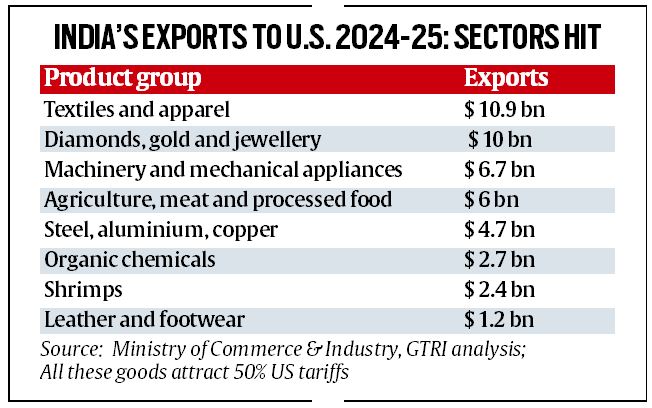POST US tariffs, the Centre’s message to exporters has been to try and hold on to their market share in the US. Two key economic ministries — finance and commerce — met exporters across key affected sectors, and suggested relief measures similar to those put in place during Covid, to tide over the current crisis.
But no succour has been forthcoming with weeks passing by since the reciprocal tariffs and secondary tariffs kicked in, and exporters are now beginning to feel the pain. Sources in the economic ministries said letters and enquiries from exporters have resulted in increased discomfiture. Having led the talks with exporters and promised intervention to meet their cash flow, ministries are finding themselves in a piquant situation.

The sources said deliberations at the highest levels over relief measures have not made much headway since unknowns such as the end date for sops and concessions, make it difficult to announce an open-ended package. Further, the Covid experience suggested that while other countries expanded the fisc generously, India was more cautious and it helped the government.
“The government did provide free foodgrains during Covid; but the larger focus then too was on reforms for the long-term — creating an AatmaNirbhar Bharat. Now also, there have been discussions on what reforms can be pursue given the circumstances, with an eye on the medium to long term,” a senior official who did not wish to be named told The Indian Express.

Businesses are writing to the Ministry of Finance and the Ministry of Commerce and Industry to seek support measures that could help them maintain competitiveness in the US market. Losing market share in the US, exporters said, will cause long-term pain. Exporters’ concerns assume significance also because uncertainty on US tariffs continues to raise the risk of job losses.
While talks have resumed, no new dates for formal negotiations have been released by the government. A US official said while the last meeting between the two countries went well, the resolution of the Russian oil issue would be central to the trade deal between them.
“The exporters have started feeling the pain because, till now, front loading was happening and quite a few sectors were protected by the US importers. There are limitations to how much the importers can protect Indian exporters, because they have alternatives in Vietnam, Indonesia, and Bangladesh. A lot of things were being handled through personal equations, but time is running out. So mitigation measures are needed immediately,” a second official said on condition of anonymity.
Story continues below this ad
“The pain is most acute among exporters, especially those who have 100 per cent exposure in the US market. Several units in Special Economic Zones (SEZs) have written to the government asking to be denotified as they wish to exit. Time is of the essence here, and certain measures were taken during COVID-19 which can be implemented to bring relief,” the official quoted above said.
Another official said there remain differences between the Ministry of Commerce and the Ministry of Finance on how relief measures should be given. The Ministry of Commerce has proposed several measures, such as Domestic Tariff Area (DTA) sales and reverse job work, which would allow units in SEZs to provide services and goods to the domestic market, but the Department of Revenue is not on the same page, a third official said.
“There are differences even in the Scheme for Remission of Duties and Taxes on Exported Products and interest equalisation schemes for exporters. There could be relief through the Merchandise Exports from India Scheme, but by the time guidelines are issued, it could be too late,” the official said.
The official said a number of measures have been discussed, but efforts are aimed at making them effective and supporting exporters in the long run. “The Ministry of Commerce and Industry is even willing to let the Ministry of Finance take the lead on this issue, and take the acknowledgement for it too, but some or the other the measures have to be implemented,” the official said.
Story continues below this ad
However, sources said that beyond the package, the Ministry of Commerce and Industry is working to offer relief to exporters in other ways, such as introducing measures to boost e-commerce exports. “Last week, multiple talks took place to decide on the guardrails to involve e-commerce companies to help boost exports by sourcing more and more products from Indian MSMEs,” the official said.
On July 31, US President Donald Trump imposed 25 per cent reciprocal tariffs on India under the International Emergency Economic Powers Act. On August 6, Trump signed an executive order imposing an additional 25 per cent penal tariff citing India’s imports of Russian oil. India exported goods worth $87 billion to the US in 2024-25. The Finance Ministry has estimated that the tariffs would affect 55 per cent of these exports.
Meanwhile, in Niti Aayog last week, government officials from various sectors met to discuss easing quality control orders (QCOs) in areas where India does not produce those specific goods. An official said this could address several concerns flagged by manufacturers, especially in labour-intensive sectors such as textiles.
Vinod Kumar, President of India SME Forum, told The Indian Express that RBI guidelines issued for banks on October 1 will significantly reduce compliance burdens for small exporters entering e-commerce exports. To facilitate the timely closure of entries in the Export Data Processing and Monitoring System and Import Data Processing and Monitoring System, RBI announced multiple directions for consignments of value equivalent to ?10 lakh per entry or bill or less.
Story continues below this ad
According to Ajay Srivastava, founder of the New Delhi-based think tank Global Trade Research Initiative (GTRI), there are four broad areas where intervention from the government would help. One is the activation of the Market Access Initiative and Interest Equalisation Scheme. There is also a need to implement pending announcements, including the Export Promotion Mission, Bharat Trade Net, and E-commerce Export Hubs, to boost digital and MSME-led exports.
Alongside, there is a need to fix procedures by speeding up customs clearance, and simplifying the Advance Authorisation Scheme. By substantially raising export promotion budgets, the government can give “broad-based, predictable support to Indian exporters”, Srivastava said.
Meanwhile, exporters, especially those in labour-intensive sectors such as textiles and apparel and gems and jewellery, have held multiple meetings with Finance Minister Nirmala Sitharaman, Commerce Minister Piyush Goyal, and RBI Governor Sanjay Malhotra to seek relief.
After a September 3 meeting with Export Promotion Councils, the Commerce and Industry Ministry said in a statement that Goyal chaired the meeting which sought “to address rising global tariffs, explore solutions, and chart a path forward amid shifting trade dynamics”.
Story continues below this ad
“Goyal reaffirmed the government’s unwavering commitment to safeguarding the interests of Indian exporters amidst the evolving global trade scenario. He assured industry representatives that the government is actively engaged in creating an enabling environment to help exporters navigate recent challenges,” the ministry said in the statement.
Sitharaman too met textile exporters in Chennai on September 3. More recently, on September 24, Gem & Jewellery Export Promotion Council Chairman Kirit Bhansali met her in Delhi to seek urgent relief measures for the gem and jewellery sector. “We are pleased that India–US trade discussions have resumed, which is encouraging news. However, the process may take time, and until a resolution is achieved, it is essential to introduce relief measures to help the sector survive and sustain employment,” Bhansali said.
The council said it has requested further interventions from the government to help the sector survive and sustain employment until the ongoing India–US trade negotiations are concluded. “These include measures such as allowing reverse job work and DTA sales by SEZ units, extending export obligation periods for US shipments, providing an interest moratorium on packing credit and working capital loans, and offering liquidity support to exporters,” it said.



































